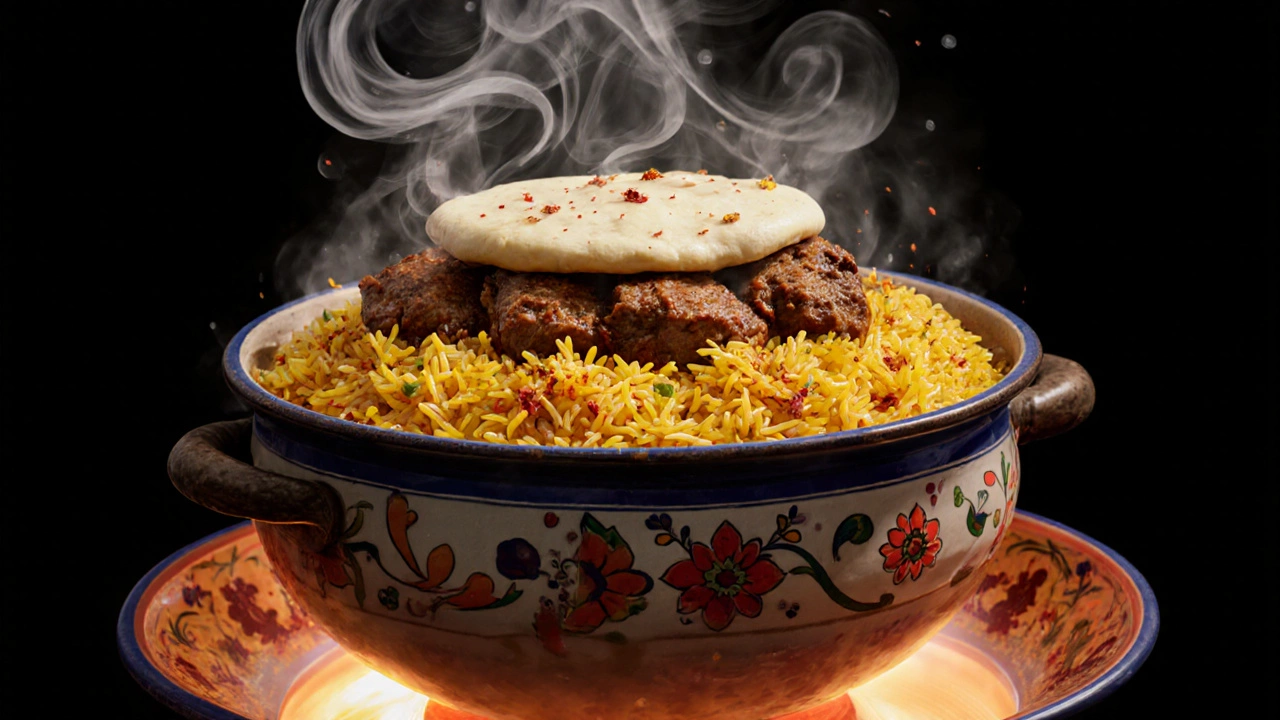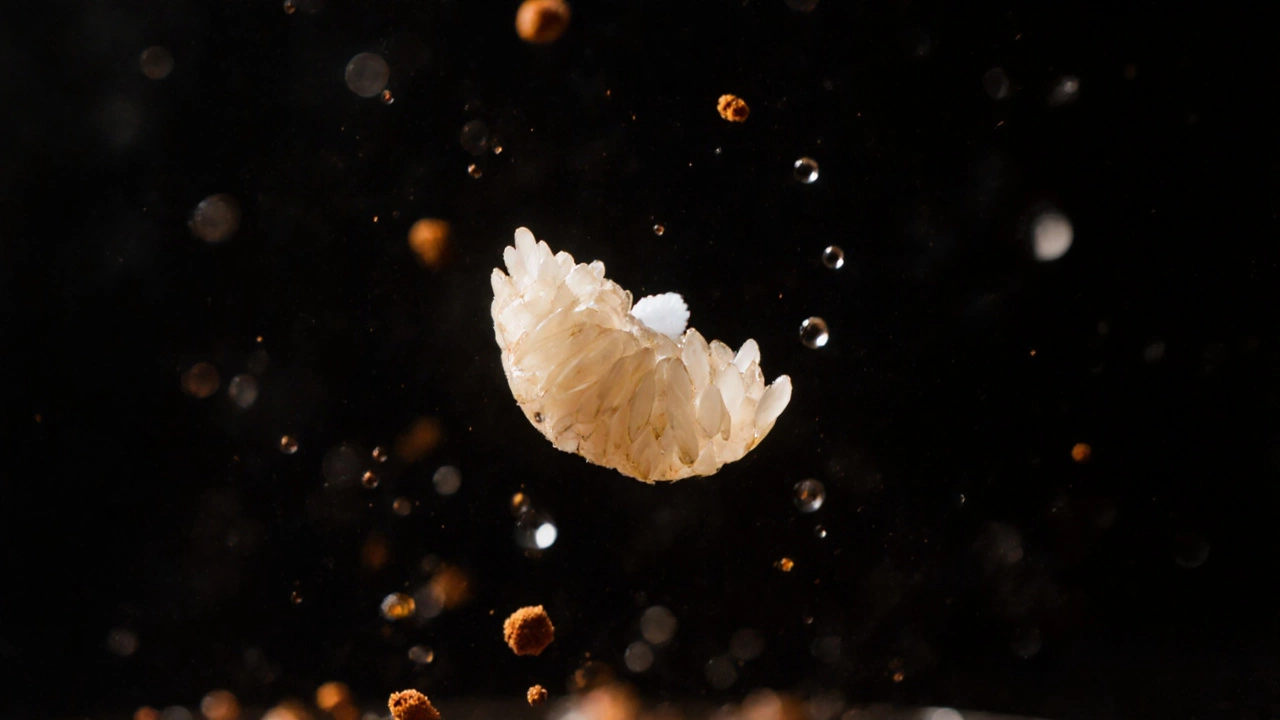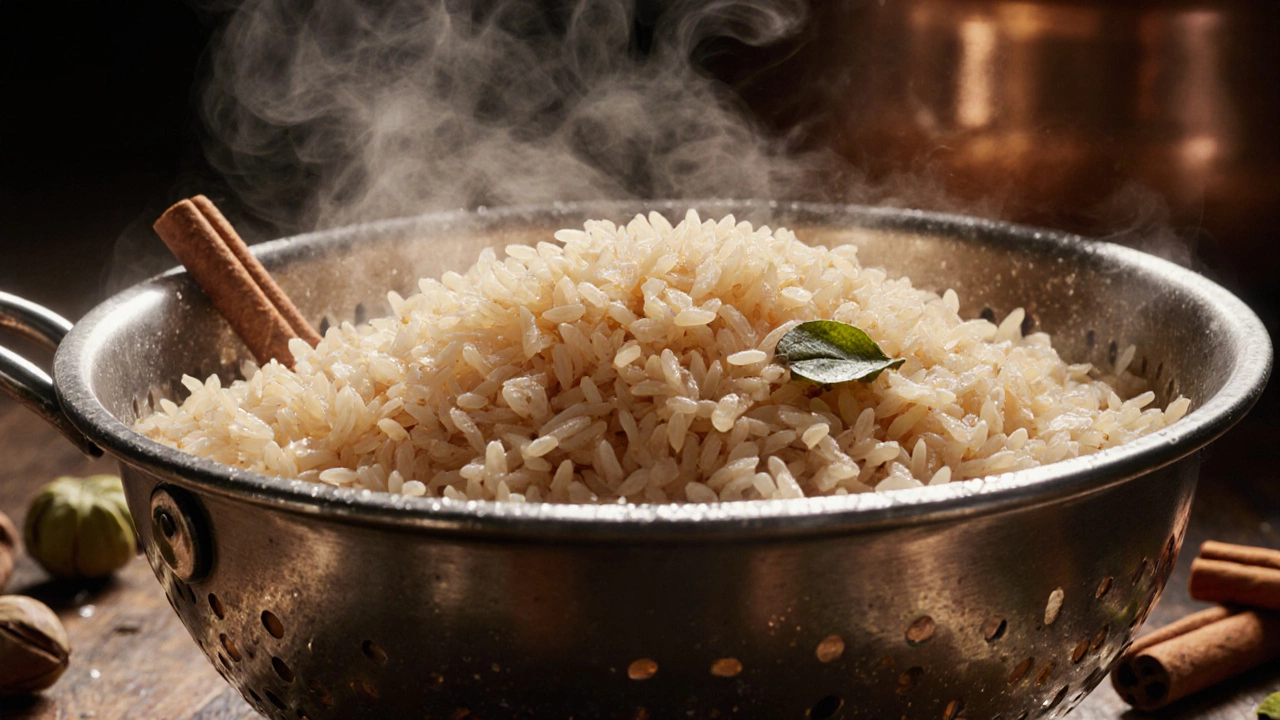Biryani Rice Parboiling Calculator
Calculate Perfect Parboiling Time
Get the right rice texture for authentic biryani with precise timing
Optimal Parboiling Time
How to Check Perfection
✓ Bite test: Center should have slight white dot
✓ Water test: Sinks slowly upright
✗ Overcooked: Squishes flat
✗ Undercooked: Hard center
Getting the rice right in biryani isn’t just about cooking it until it’s soft-it’s about timing it so each grain stays separate, fluffy, and perfectly infused with spice. Too little time, and you’ll end up with hard, chalky grains that ruin the whole dish. Too long, and the rice turns mushy, sticking together like glue. The sweet spot? Parboiling basmati rice for 7 to 8 minutes is the golden rule for most traditional biryani recipes.
Why Parboiling Matters More Than Full Cooking
Many people think you need to cook the rice all the way through before layering it with meat or vegetables. That’s a mistake. Biryani is a dum-cooked dish-meaning the rice finishes steaming in the pot with the rest of the ingredients. If you fully cook the rice before layering, it’ll turn soggy and fall apart during the final steam. The goal is to parboil it just enough so the center is still slightly firm, like an al dente pasta.
When you layer parboiled rice with marinated chicken, lamb, or vegetables and then seal the pot with dough or a tight lid, the residual heat and steam finish the cooking process. That’s how you get those long, intact grains that don’t clump. It’s the same technique used in Hyderabadi and Lucknowi biryanis, where texture is everything.
Choosing the Right Rice
Not all rice works for biryani. You need long-grain basmati-it’s the only type that stays separate after cooking and releases that signature aroma. Look for aged basmati, preferably from India or Pakistan. Aged rice (1-2 years old) has less moisture, which means it absorbs flavors better and elongates beautifully when cooked.
Don’t use short-grain rice like sushi rice or medium-grain varieties like jasmine. They’re too starchy and will turn sticky. Even if you cook them perfectly, they won’t give you that light, airy texture biryani needs. Stick to basmati. If you can’t find aged basmati, regular basmati works fine-you’ll just need to rinse it extra well.
How to Prep the Rice Before Boiling
Before you even turn on the stove, rinse the rice at least 4-5 times under cold water. Keep rinsing until the water runs clear. This removes excess starch that causes clumping. After rinsing, soak the rice for 30 minutes. Soaking helps the grains absorb water evenly, so they cook uniformly. Skip this step, and you’ll end up with some grains undercooked and others overcooked.
Use a large pot with plenty of water-about 4 cups of water for every 1 cup of rice. Add a teaspoon of salt and a few whole spices like a cinnamon stick, 2-3 green cardamom pods, and a bay leaf. These infuse the rice with flavor from the start. You can also add a splash of lemon juice or a teaspoon of oil to keep the grains from sticking.
Step-by-Step Parboiling Process
- Bring the salted, spiced water to a full rolling boil.
- Add the soaked, drained rice. Stir gently once to separate grains.
- Let it boil uncovered for 7 minutes. Do not stir after the first minute.
- Test a grain: it should be about 70% cooked-firm in the center but soft on the outside. Bite into it. If there’s a white dot in the middle, it’s perfect.
- Drain immediately in a colander. Don’t rinse after draining-that washes away flavor.
- Spread the rice on a tray to cool slightly before layering. This stops the cooking process and keeps grains separate.
Timing matters more than you think. At 6 minutes, the rice is too hard. At 9 minutes, it’s too soft. Stick to 7-8 minutes. If you’re cooking at high altitude (like in parts of New Zealand), add 30 seconds to a minute-water boils at a lower temperature up here.

Common Mistakes That Ruin Biryani Rice
- Using too little water-rice won’t cook evenly and burns on the bottom.
- Stirring after adding rice to boiling water-breaks the grains and releases starch.
- Not soaking the rice-leads to uneven cooking and hard centers.
- Draining and rinsing after parboiling-washes away spice flavor.
- Leaving rice in the hot colander too long-continues cooking and gets mushy.
One mistake I see even experienced cooks make: adding the rice to cold or lukewarm water. That’s how you get mush. Always start with boiling water. The sudden heat sets the outer layer of the grain, locking in texture.
How to Tell If Your Rice Is Perfectly Parboiled
Here’s a simple test: take one grain, press it gently between your fingers. If it bends slightly but doesn’t snap, and the center still feels a bit resistant, you’ve nailed it. If it breaks easily, it’s underdone. If it squishes flat, it’s overdone.
Another trick: drop a grain into a glass of cold water. If it sinks slowly and stays upright, it’s just right. If it floats or sinks fast, it’s either under or overcooked.
What If You Overcook the Rice?
If you accidentally boil it for 10 minutes and it’s too soft, don’t panic. Spread it out on a baking sheet and let it air-dry for 10-15 minutes. Then toss it lightly with a tablespoon of cold water and a pinch of salt. This rehydrates the surface just enough to help it hold together without turning to mush when layered.
Still too soft? Use it in a khichdi or fried rice the next day. Don’t try to force it into biryani-it’ll ruin the texture.

Pro Tips for Perfect Biryani Rice Every Time
- Use a timer. Set it for 7 minutes. Don’t guess.
- Keep the lid off while boiling. Steam escaping helps control texture.
- Don’t overcrowd the pot. Cook rice in batches if needed.
- Use a heavy-bottomed pot to avoid hot spots.
- Let the rice cool slightly before layering-warm rice steams too fast and gets soggy.
- For extra fragrance, toast whole spices in ghee before adding water to boil the rice.
Once you get the timing down, biryani becomes less of a recipe and more of a rhythm. It’s about listening to the rice-how it looks, how it feels, how it smells. That’s the real secret.
Does the Type of Biryani Change the Time?
Not really. Whether you’re making Hyderabadi, Kolkata, or Sindhi biryani, the parboiling time stays the same: 7-8 minutes. The differences come from the spices, meat, and layering technique-not the rice prep. Even vegetarian biryani uses the same rice method. The only variation is in the broth you use to boil the rice-some use vegetable stock, others use water with saffron soaked in milk. But the cooking time? Still 7-8 minutes.
One exception: if you’re using brown basmati rice. That needs longer-about 12-14 minutes of boiling. But most biryanis call for white basmati, so stick to the standard unless you’re going for a healthier twist.
Can I use instant or precooked rice for biryani?
No. Instant or precooked rice is already fully cooked and dehydrated. It won’t absorb flavors properly and turns mushy when steamed. Stick to raw, aged basmati rice for authentic texture.
Should I rinse the rice after parboiling?
Never rinse after parboiling. Rinsing washes away the spice flavors infused during boiling and makes the rice slippery, which prevents it from holding layers properly in the pot.
How much water should I use to boil biryani rice?
Use 4 cups of water for every 1 cup of rice. The water should be well-salted and spiced. You want enough to let the rice move freely, so it doesn’t stick or clump.
Can I boil rice in chicken or vegetable stock instead of water?
Yes, and it adds depth. Use homemade stock without excess salt, since you’re already salting the water. Store-bought stock often has too much sodium-dilute it with half water if needed.
Why does my biryani rice turn out sticky even when I follow the time?
You probably didn’t rinse the rice enough before soaking. Excess starch is the #1 cause of stickiness. Rinse until the water runs clear, soak for 30 minutes, and don’t stir after adding to boiling water.
Final Thought: It’s Not Just Time-It’s Technique
Boiling rice for biryani isn’t a countdown. It’s a sensory process. Watch the water. Smell the spices. Feel the grain. Once you’ve done it a few times, you’ll know by sight and sound when it’s ready. That’s when your biryani stops being a recipe and becomes a tradition.
